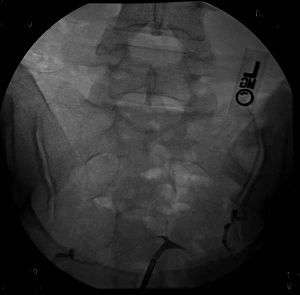T-shaped uterus
A t-shaped uterus is a type of uterine malformation wherein the uterus is shaped resembling the letter T.[1] This is typically observed in DES-exposed women.[2] It is recognised in the ESHRE/ESGE classification,[3] and is associated with failed implantation, increased risk of ectopic pregnancy, miscarriage and preterm delivery. There is a surgical procedure to correct the malformation.[4]
_cervix_(43).jpg)
| T-shaped uterus | |
|---|---|
 | |
| Hysterosalpingography of a T-shaped uterus. |
Causes
The t-shaped malformation is commonly associated with in-utero exposure (the so-called "DES-daughters") to DES, although it is also presented congenitally.[5]
Diagnosis
Women are often diagnosed with this condition after several failed pregnancies, proceeded by exploratory diagnostic procedures, such as magnetic resonance, sonography, and particularly hysterosalpingography.[6][7][8] In such studies, a widening of the interstitial and isthmus of uterine tube is observed, as well as constrictions or narrowing of the uterus as a whole, especially the lower and lateral portions, hence the "t" denomination. The uterus might be simultaneously reduced in volume, and other abnormalities might be concomitantly present.[9]
Prognosis
T-shaped uterus sufferers can bear children, however they carry a greater risk of complications, such as miscarriages, reduced fertility and preterm births, both before and after any treatment.[10][11]
The current surgical procedure to treat this malformation, termed a hysteroscopic correction or metroplasty, is undertaken by performing a lateral incision of the uterine walls, and can return the organ to a normal morphology, while improving the patient's former reproductive performance.[4][10][12] It is considered a low-risk procedure, and can also improve term delivery rate by up to 10-fold, as long as the endometrium is considered to be in good condition.[13][14][15] However, risks after the procedure include placenta accreta, Asherman's syndrome and severe haemorrhage.[4][16]
See also
References
- Ben-Baruch G, Menczer J, Mashiach S, Serr DM (1981). "Uterine anomalies in diethylstilbestrol-exposed women with fertility disorders". Acta Obstet Gynecol Scand. 60 (4): 395–7. doi:10.3109/00016348109154132. PMID 7282306.
- Rennell CL (1979). "T-shaped uterus in diethylstilbestrol (DES) exposure". AJR Am J Roentgenol. 132 (6): 979–80. doi:10.2214/ajr.132.6.979. PMID 108980.
- Grimbizis GF, Gordts S, Di Spiezio Sardo A, Brucker S, De Angelis C, Gergolet M, et al. (2013). "The ESHRE/ESGE consensus on the classification of female genital tract congenital anomalies". Hum Reprod. 28 (8): 2032–44. doi:10.1093/humrep/det098. PMC 3712660. PMID 23771171.
- Meier, Rose; Campo, Rudi (2015). "T-Shaped Uterus". Female Genital Tract Congenital Malformations: 261–270. doi:10.1007/978-1-4471-5146-3_25.
- Pui MH (2004). "Imaging diagnosis of congenital uterine malformation". Comput Med Imaging Graph. 28 (7): 425–33. doi:10.1016/j.compmedimag.2004.05.008. PMID 15464882.
- Baramki TA (2005). "Hysterosalpingography". Fertil Steril. 83 (6): 1595–606. doi:10.1016/j.fertnstert.2004.12.050. PMID 15950625.
- Viscomi, G N; Gonzalez, R; Taylor, K J (1980). "Ultrasound detection of uterine abnormalities after diethylstilbestrol (DES) exposure". Radiology. 136 (3): 733–735. doi:10.1148/radiology.136.3.7403556. ISSN 0033-8419. PMID 7403556.
- van Gils AP, Tham RT, Falke TH, Peters AA (1989). "Abnormalities of the uterus and cervix after diethylstilbestrol exposure: correlation of findings on MR and hysterosalpingography". AJR Am J Roentgenol. 153 (6): 1235–8. doi:10.2214/ajr.153.6.1235. PMID 2816640.
- Kaufman RH, Binder GL, Gray PM, Adam E (1977). "Upper genital tract changes associated with exposure in utero to diethylstilbestrol". Am J Obstet Gynecol. 128 (1): 51–9. PMID 851159.
- Katz Z, Ben-Arie A, Lurie S, Manor M, Insler V (1996). "Beneficial effect of hysteroscopic metroplasty on the reproductive outcome in a 'T-shaped' uterus". Gynecol Obstet Invest. 41 (1): 41–3. doi:10.1159/000292033. PMID 8821883.
- Berger MJ, Goldstein DP (1980). "Impaired reproductive performance in DES-exposed women". Obstet Gynecol. 55 (1): 25–7. PMID 7352058.
- Lin, Paul C; Bhatnagar, Kunwar P; Nettleton, G.Stephen; Nakajima, Steven T (2002). "Female genital anomalies affecting reproduction". Fertility and Sterility. 78 (5): 899–915. doi:10.1016/S0015-0282(02)03368-X. ISSN 0015-0282.
- Noyes N, Liu HC, Sultan K, Rosenwaks Z (1996). "Endometrial pattern in diethylstilboestrol-exposed women undergoing in-vitro fertilization may be the most significant predictor of pregnancy outcome". Hum Reprod. 11 (12): 2719–23. doi:10.1093/oxfordjournals.humrep.a019197. PMID 9021378.
- Giacomucci E, Bellavia E, Sandri F, Farina A, Scagliarini G (2011). "Term delivery rate after hysteroscopic metroplasty in patients with recurrent spontaneous abortion and T-shaped, arcuate and septate uterus". Gynecol Obstet Invest. 71 (3): 183–8. doi:10.1159/000317266. PMID 21150155.
- Golan A, Langer R, Neuman M, Wexler S, Segev E, David MP (1992). "Obstetric outcome in women with congenital uterine malformations". J Reprod Med. 37 (3): 233–6. PMID 1564709.
- Fernandez, H.; Garbin, O.; Castaigne, V.; Gervaise, A.; Levaillant, J.-M. (2011). "Surgical approach to and reproductive outcome after surgical correction of a T-shaped uterus". Human Reproduction. 26 (7): 1730–1734. doi:10.1093/humrep/der056. ISSN 0268-1161. PMID 21398337.
Further reading
- Kaufman RH (1982). "Structural changes of the genital tract associated with in utero exposure to diethylstilbestrol". Obstet Gynecol Annu. 11: 187–202. PMID 7110645.
- Goldberg, Jeffrey M; Falcone, Tommaso (1999). "Effect of diethylstilbestrol on reproductive function". Fertility and Sterility. 72 (1): 1–7. doi:10.1016/S0015-0282(99)00153-3. ISSN 0015-0282. PMID 10428139.
- KALTFMANL, RAYMOND H., MD ERVIN ADAM, and Gary L. Binder. "Upper genital tract changes and pregnancy outcome in offspring exposed in utero to diethylstilbestrol." (1980).
- Lin PC (2004). "Reproductive outcomes in women with uterine anomalies". J Womens Health (Larchmt). 13 (1): 33–9. doi:10.1089/154099904322836438. PMID 15006276.